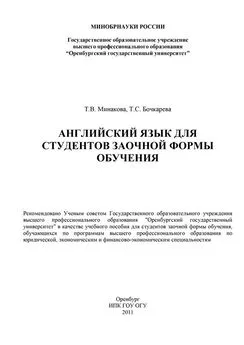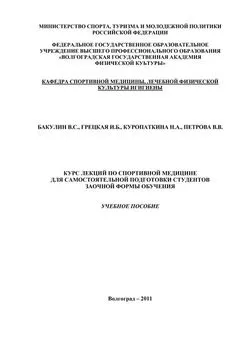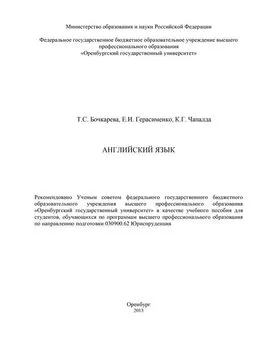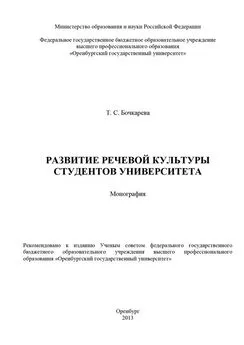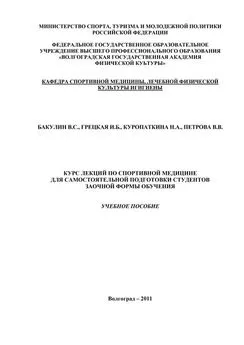Татьяна Бочкарева - Английский язык для студентов заочной формы обучения
- Название:Английский язык для студентов заочной формы обучения
- Автор:
- Жанр:
- Издательство:Литагент БИБКОМ
- Год:2011
- Город:Оренбург
- ISBN:нет данных
- Рейтинг:
- Избранное:Добавить в избранное
-
Отзывы:
-
Ваша оценка:
Татьяна Бочкарева - Английский язык для студентов заочной формы обучения краткое содержание
Английский язык для студентов заочной формы обучения - читать онлайн бесплатно ознакомительный отрывок
Интервал:
Закладка:
preserve competition – сохранить конкуренцию;
prevent monopolistic control – предотвратить монополистический контроль;
benefits of competition – преимущества конкуренции;
incentive – стимул, побудительный мотив;
procurement assistance – материально-техническая помощь;
gross national product – валовой национальный продукт;
create new jobs – создавать новые рабочие места;
supply – снабжать, поставлять;
ownership – собственность;
retailing – розничная торговля;
wholesaling – оптовая торговля;
manufacturing – производство;
total assets – общая стоимость имущества, сумма баланса;
net worth – стоимость имущества за вычетом обязательств, собственный капитал (предприятия);
gross profits – валовая прибыль;
net profits – чистая прибыль;
payroll – платежная ведомость;
net receipts – чистая выручка, чистые доходы, чисты денежные поступления;
total sales – общий объем продаж, товарооборот;
return – возмещение, возврат; pl. возвращенный товар; возвращенные чеки, векселя;
allowances – начисления (например сумма накладных расходов;
keep records – вести учет;
tax – налог;
bank loan – банковская ссуда;
partnership – партнерство;
business premises – 1) торговое помещение; 2) помещение фирмы;
labour force – рабочая сила;
business failure – коммерческий крах;
profit – прибыль;
assets – активы, фонды, средства liabilities – пассивы;
денежные обязательства, долги;
earnings – 1) заработок pl. ; 2) доход, прибыль, поступление;
advertising agency – рекламное агентство;
warehouse – склад;
оптовый магазин;
tangible – материальный;
intangible – нематериальный;
notes receivable – амер. векселя к получению;
cash – наличность;
equipment – оборудование;
real estate – недвижимость;
retail business – розничная торговля;
surplus – 1) излишек, избыток; 2) нераспределенная прибыль;
total receipts – общая сумма поступления;
bookkeeping – бухгалтерский учет;
merchandise – товары;
money borrowed – деньги, взятые взаймы;
in bulk orders – заказ в большом количестве;
financial investment – финансовые инвестиции.
2.2.4.2 Задание 2. Прочитайте текст переведите его письменно
Today small businesses are the heart of the market economy. There are a great number and variety of small businesses. People become owners and operators of small business firms in one of three ways: start a new firm, buy a franchise, buy or inherit an existing firm.
Small firms have been established to do just about any kind of business imaginable. They have been established to manufacture and distribute goods, to sell them at retail, and, of course, to provide all kinds of needed services. Some serve only the local community, while others function in national and international markets.
The vast majority of small firms concentrate on selling material products, although an increasing number of firms provide a service. Although an increasing number operate in local markets, services, too, are exported. In recent years there has been a great increase in the export of services, such as management consulting, medical, and technological services.
The existence of a strong, healthy small business community has always been recognized as the best way to preserve competition, prevent monopolistic control of any industries, and thus assure the population of the benefits of competition through better prices and quality products. Incentives have been provided to assist small firms. The government of the US created the Small Business Administration (SBA) in 1954 to provide financial, management, and procurement assistance for small firms.
There are some facts that illustrate the importance of small business. According to the Small Business Administration:
– 99 % of all businesses in the US can be classified as small;
– 43 % of the gross national product is contributed by small business;
– while large business has been cutting back employment, small business has been creating new jobs;
– many of new products and services in the US are created by small businesses.
Numerous definitions of the term "small business" exist. A small business is one which is independently owned and operated and not dominant in its field of operation. A small business is one which possesses at least two of the following four characteristics: 1) management of the firm is independent. Usually the managers are also the owners; 2) capital is supplied and the ownership is held by an individual or a small group; 3) the area of operation is mainly local, with the workers and owners living in one home community. However, the markets need not be local; 4) the relative size of the firm within its industry must be small when compared with the biggest units in its field. Of the characteristics cited, most scholars believe that the fourth, relative size, is the most important.
The SBA traditionally uses the following criteria for defining small business: retailing (sales volume), service (sales volume), wholesaling (sales volume), manufacturing (number of employees).
The following is a list of terms that can be used to describe a business. Each term tells something about the size of a business. Total assets – all that a business owns.
Net worth – business assets less what is owed.
Gross profits – money left from sales after all expenses (except taxes) have been paid.
Net profits – what is left from gross profit after business income taxes are paid. Employees – total number of workers and managers listed on the payroll.
Income- net receipts, the total sales less returns, allowances, and discounts.
It is necessary to keep records of a business for tax purposes and as a measure of growth. Some businesses fail because they are improperly expanded. Other businesses are unsuccessful because they expand too quickly and cannot handle problems that come with rapid growth. Many businesses remain small and provide excellent income throughout their lifetime.
Business operations are subject to review by local, state, and federal authorities. These reviews insure that rules and regulations are being obeyed and standards maintained. Some of the operations subject to review are listed here.
Income. Business income must be reported for income tax purposes. Other reasons for reporting business income include providing information for bank loans, attracting investors, making equitable distribution of profits in partnership, and as a measure of business growth. The records are usually subject to an audit.
Working conditions. Clean and safe working conditions must be provided for employees and if required, medical and safety equipment must be provided.
Wages and hours. Work regulations and announcements must be posted where employees ,can read them. Employers must pay at least the minimum wagelthat applies to their employees.
Advertising, labelling, and packaging. Businesses must not be guilty of false advertising, mislabeling, or providing less than the labeled weight in a package.
Unfair practices. Laws prevent business persons from engaging in various unfair practices, such as price fixing, and other means of restraining trade.
Discrimination. Federal and state regulations prevent an employee from being discriminated against because of color, race, sex, religion, or national origin.
Liability and соmpensatiоn. Employers are required to carry insurance and provide adequate compensation for workers injured on the job and customers injured on the business premises.
2.2.4.3 Ответьте на вопросы по тексту
1) How do people become owners and operators of small business firms?
2) What are the aims of establishing small firms?
3) What has always been recognized as the best way to preserve competition, prevent monopolistic control of any industries?
4) What facts illustrate the importance of small business?
5) Can you define a small business?
6) What is the most important characteristic of a small business?
7) What criteria are used for defining small business?
8) What terms describe the size of a business?
9) What operations of a small business are subject to review?
2.2.5 Тексты для студентов специальности «Налоги и налогообложение
2.2.5.1 Задание 1. Прочитайте и запомните следующие слова и словосочетания:
tax /levy – налог
levy/impose taxes. syn. to tax – облагать налогом и собирать взимать налоги
tax burden – налоговое бремя
direct tax – прямой налог indirect tax – косвенный налог (на товары и услуги)
personal income tax – налог на доходы граждан/физических лиц
tax-payer – налогоплательщик
excise (duty) – акциз, акцизный сбор
corporation/company tax – налог на прибыль корпорации/компании
tax rate – налоговая ставка
tax base – база налогового обложения
tax administration – порядок взимания налогов, администрирование
social insurance tax – социальный налог
tax revenues – налоговые поступления, доходы от налогов
value added tax (VAT) – налог на добавленную стоимость – НДС
tax – exempt – свободный от уплаты налогов
overall tax intake – общая сумма налогов
eanings – доход equity [‘ekviti] – соразмерность налога доходу
corporate – организация, обладающая правами юридического лица
individual – физическое лицо
depreciation – обесценивание, амортизация
Tax Code – налоговый кодекс
allowance – скидка, льгота
2.2.5.2 Задание 2. Прочитайте тексты А, В, С, D переведите их письменно
Text A. Taxes and Fiscal Policy
In every society governments spend money on, goods and services for people as national defence, public education, transport and others. As a rule, government expenditure spending is chiefly financed through imposing taxes. A tax is money one must pay to the government to support its different programs. Hence, a system used by governments to collect taxes from people and organizations is called taxation. To put it differently taxation is the process by which people pay the expenses carried by the government. With in an economy there exists an instrument which is used to regulate taxation and government spending. This instrument is fiscal policy. Taxes and fiscal policy are actually parts of an economic circle as shown in the figure below:
Читать дальшеИнтервал:
Закладка:
